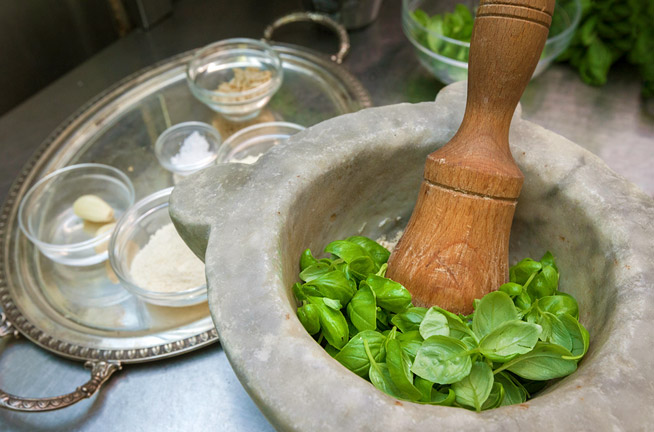
The official Recipe of Pesto Genovese
First of all, let us warn you that on the market, under the name of “Pesto Genovese”, you could find misleadingly labeled products that do not adhere to the original recipe as, for example, pesto prepared with the addition of ricotta cheese, cashews, cheap seed oil (instead Extra Virgin Olive Oil) or many other ingredients have nothing to do with our original sauce. So, it’s important to always carefully read the product label to be sure of what you’re buying.
The authentic traditional recipe of Genovese Pesto is prepared with the 7 ingredients contemplated by the Consortium and guarantors of an ancient regional heritage, such as: PDO Genovese basil, Extra Virgin Olive Oil, preferably from the Ligurian Riviera, PDO Parmigiano Reggiano (with Grana Padano variant), PDO Pecorino Sardo, Pine nuts, Garlic and Salt.
INGREDIENTS TO SEASON 600 GRAMS OF PASTA
PDO Genovese Basil (for more info click here)
• 50 grams of small leaf basil.
Basil, if possible young and fresh, must meet the quality and varietal requirements set out in the specification which governs the proper use of the name “Basilico Genovese”, whether used directly or as an alternative component of a semi-finished product composed of Genovese basil, fresh or preserved, extra virgin olive oil produced in Liguria or obtained in adjacent Italian regions.
Extra Virgin Olive Oil (for more info about EVO Oil Riviera Ligure PDO click here)
• half glass.
Possibly from the Ligurian Riviera or produced in contiguous Italian regions and must meet the requirements of Regulation 796/02/ EEC.
PDO Parmigiano Reggiano (with Grana Padano variant)
• 6 tablespoons.
PDO Pecorino (Fiore Sardo)
• 2 tablespoons.
Garlic
• 2 cloves.
Vessalico garlic is best for its delicate flavour.
Pinoli
• 1 tablespoon.
Obtained from Pinus pinea must be produced in the Mediterranean area.
Coarse sea salt
• a few grains.
HOW TO MAKE THE REAL GENOVESE PESTO
To make real Genoese Pesto you need a marble mortar, a wooden pestle and a lot of patience. The first written recipe for Pesto that has come down to us from the mid 1800’s and since then, except for hasty profanations in the technique of execution, it has not changed.
First of all, the basil, must be washed in cold water and then left to dry on a dish towel. In the meantime, one clove of garlic must be crushed in the mortar for every 30 basil leaves.
The garlic must be sweet, it must not prevail even though it is present in the background… in short: it cannot be missing! And the coarse salt must not be missing either, add a few grains.
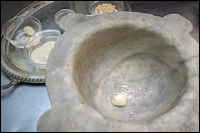
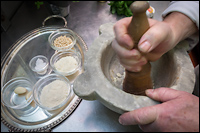
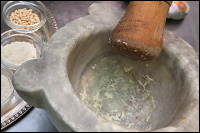
When the garlic and salt have reached the consistency of a cream, it is time to add the pine nuts, a handful. The pine nuts will soften and amalgamate the sauce, giving it that gentle bouquet that contrasts with the garlic, they are an added touch, the artist’s touch. Those of high quality are national and, of course, are more expensive but on this occasion we want to dispel the myth of thriftiness of Genoese people and we will choose for the best, after all, pine nuts are present in all our important recipes.
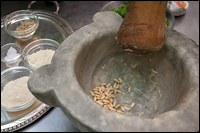
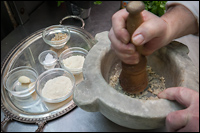
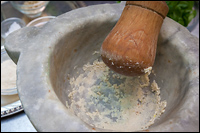
At this point, but not all at once (they are precious commodities, not just herbs), add the basil leaves and start with a gentle and prolonged rotary motion to pound them in the mortar. Remember that the essential oils of basil are preserved in the veins of its leaves and, in order to get the best flavor, you must not pound severely but rotate the pestle slightly so as to tear, not shear, the fragrant leaves. The sound of the pestle against the edges of the mortar will accompany our work.
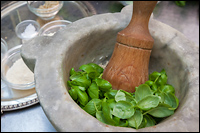

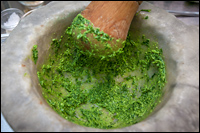
Now it’s time for the cheeses: Parmigiano Reggiano and Pecorino sardo, both PDO, properly seasoned. And finally the Extra Virgin Olive Oil, poured in drops, naturally from the Ligurian Riviera with a flavour that is not particularly aggressive, not particularly intense, ideal for marrying all the ingredients without overpowering them.
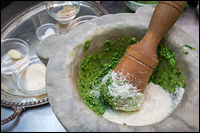


At this point Pesto Genovese is ready and can be used to season Troffie, Trofiette, Trenette, Mandilli de Saea and can be added to give flavor to Minestrone. If your Pesto is too “compact”, just add some hot cooking water of the pasta to dilute the product before seasoning.
ADDITION OF POTATOES AND BEANS
Although green beans and potatoes are not 2 ingredients included in the official Pesto recipe, their addition in boiling water together with pasta is a classic for serving and packaging the dish according to the ancient Genoese tradition. Among other things, the use of potato chunks cooking together with pasta is a way to further add starch to the water contributing to the creaminess of the result.
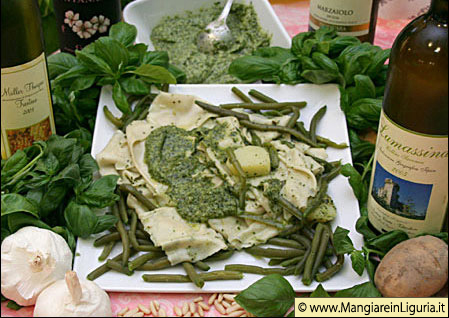
Final recommendation…
.
Pesto Genovese must be processed at ambient temperature and must be finished as quickly as possible to avoid oxidation problems. Today, in the “hurry age”, to make Pesto is also used the blender: nobody forbids the use of the blender but the flavor and color will certainly not be the same so, if you want to enjoy the best Pesto, just follow the “old-fashioned way” !!!
Historical curiosities about Pesto Genovese
(written by Bruno Bini and Prof. Giovanni Rebora)
Among the products that have contributed to the diffusion and the knowledge of the typical Ligurian products in the world, Pesto has certainly played a leading role. According to the research carried out in the archives of the most important Ligurian newspapers, Pesto was most popular between 1980 and 1990.
Among the most striking appearances in the early 1980s, the one at The Italian Fancy Food Show in New York is one of the most significant. At that time, the delicious basil sauce, the pride of Genoese cuisine, was literally “disguised” under a lively label that baptized it “Pesto Sanremo”. During the event, it received a great deal of support from visitors and producers alike. A curious detail: that Pesto was not directed towards the market of Italian-American consumers, who had vague ancestry associated with some languid Ligurian melancholy, but rather to the pure Anglo-Saxon palate that found in that sauce even a sexual stimulus.
“A sauce called pesto,” reported the “Sunday Times” in 1989, dedicating to the sauce the last episode of an investigation entitled “The Taste of Italy,” a long journey of the English newspaper into Italian gastronomic traditions.
The Secolo XIX recorded with punctuality the event with an article (January 6, 1989) with a decidedly enthusiastic tone: “[…] A sauce called pesto! The English are subjugated by basil, fascinated by how in Liguria everyone grows it in every available space, around the house as well as in pots on the windowsill.” The “Sunday Times” focused on highlighting the uniqueness of Ligurian cuisine, which, despite the region’s coastal extent, made great use of vegetables and herbs.
Claudia Rosen, author of the survey, says: “The cuisine of Liguria has none of the characteristics common to other northern regions, nor is it a cuisine based on the sea as one might expect […] there is great use of vegetables, as in Puglia, and the most amazing aspect is the abundant use of aromatic herbs.” Of the green sauce, it is explained that each locality along the coast offers its own version “[…] in Nervi cream is added, in Recco a little slightly sour ricotta.”
At the beginning of the 1990s, Pesto from the Val di Magra conquered the markets of Canada, Germany and Jordan. And then it was even exported to Honolulu in Hawaii.
On 21 March 1990, the “Secolo XIX” newspaper reported on this market success, and also reported on the extravagant idea of distributing basil-flavoured ice cream. A famous restaurant in Recco some years before drove the Filipinos crazy by presenting dishes based on the delicious sauce at the Silhais International Hotel in Manila. Pesto was a hit in Las Vegas and fascinated “The Voice“. The passion for Pesto has also caught on in the United States, where there is no shortage of Genoese restaurants and where Ligurian cuisine periodically enjoys a good reputation.
But in the course of Pesto’s triumphant march across the United States, a special mention must be reserved for what the newspapers christened the “Pesto à la Frank”. On December 12, 1991, in the year of his 75th birthday, Frank Sinatra inaugurated a food line bearing his name and image. The products were typical of Italian gastronomy: oil, sauce and above all Genoese pesto, packaged in cylindrical glass jars, wrapped in a black label on which stood out the half-bust of “The Voice”.
The new product and the secrets of Pesto were presented at the American premiere by some of the most distinguished gastronomic experts from Genoa, including Vincenzo Buonassisi and Anna Pesenti, as well as Frank Giambelli, the first and largest Italian restaurateur in New York. The commercialization of our basil sauce under the Sinatra brand name was not, to tell the truth, particularly fortunate due to the precarious budgets of the companies involved in the distribution, and problems related to the preservation of the product, not to mention the “stridor” caused by the impact of a marketing linked to a world-famous singer who was trying to gain rights from delicatessens as well as record companies.
Frequently Asked Questions about Genovese Pesto
– Why does my Pesto turn dark every time I make it?
– How do I store Pesto?
– Can I freeze it?
You can read our answers on the article
“Pesto: FAQ & Curiosities“
This article is reported on WIKIPEDIA as a source for “Pesto Genovese Recipe” (Note #13 and 14).










